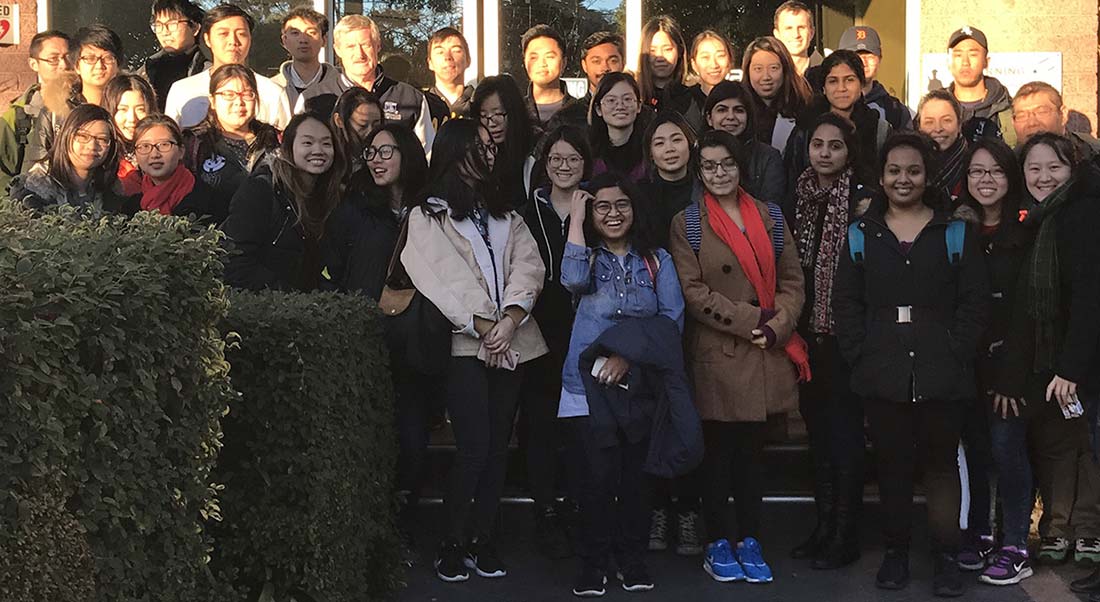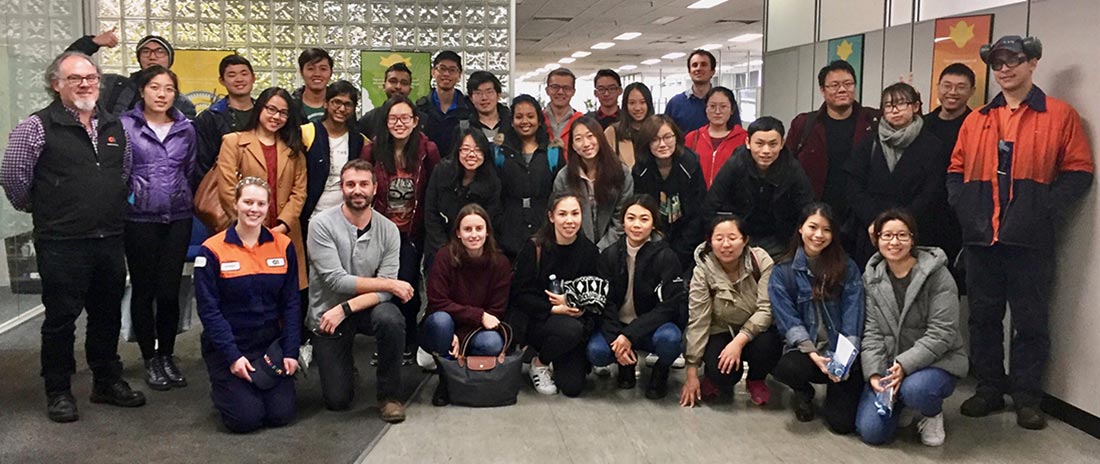As the course lecturers for both the Food Packaging Materials and Processes Unit and Food Packaging Design Unit of the Master of Food & Packaging Course at the Melbourne University, the AIP and their expert lecturers, led by Pierre Pienaar FAIP, CPP and Michael Grima MAIP, recently spent two intensive weeks with the latest intake of students in Melbourne.
37 students in all participated in the 2017 intake of the course with close to twenty industry experts providing the course content. The AIP is responsible for the course content delivery for both units and all of the course lecturers are hand-selected for their expertise by the Institute. The students were from Australia, China, India, Indonesia, Malaysia, Singapore, Taiwan and Thailand. Such wonderful diversity added another inspiring aspect to the intensive lecturing and learning experience.
FOOD PACKAGING MATERIALS AND PROCESSES UNIT
by Prof Pierre Pienaar, FAIP, CPP, AIP Education Director

What a fantastic educational week the AIP had with the 37 students on this course! Such wonderful diversity added another inspiring aspect to the intensive lecturing and learning experience.
The week was very intensive with several of the experienced AIP lecturers from industry covering a significant range of packaging technology topics. By the end of lectures each late afternoon, the students had their heads full of information which they had to digest each evening while also preparing for their poster assignment to be presented alongside their oral exam on the last day of the intensive week.
The poster assignment, which formed part of their major written assignment, was based on how convenience drives food packaging innovation; as well as how environmental sustainability drives innovation in food packaging. These are really thought provoking assignments which challenged the students to contemplate what packaging is and what its impact is on society.
Midweek, the students were kindly hosted by Sealed Air manufacturing facility in Tullamarine where they were able to learn and see right up close how rigid plastic containers are produced. This firsthand experience they found most enlightening. After presentations by Sealed Air, a factory tour and wonderful tasty lunch, they were off to the Sealed Air manufacturing facility in Faulkner. Here they enjoyed another factory tour but this time to see the manufacturing of flexible packaging.
This certainly assisted the students to process the theory they had learnt.
Thursday saw the students back in the lecture theatre but with a fresh mind about packaging from their previous, practical day in the factories. The involvement and questioning during lectures by the students was most encouraging to all the lecturers. Students researched their selected topics well and lecturers spent late afternoons and early evenings still answering eager questions from the students.
As one student said,
“There is so much to remember and consider in packaging. “
Another said,
“I use packaging everyday but never thought about all that went into creating a pack.”
Friday saw some sleepy students that had been up in the early hours to complete their posters. The oral exam for the students was a presentation of their respective poster plus a 3-minute explanation of what they were trying to achieve by way of the poster. The two course co-ordinators then questioned them. The standard was reasonably good with some real standout students getting their message across very well.
The final part of the intensive for students is a written 1000 word essay on a given topic relating to the subject. Here the students’ needs to get the message across, meet the criteria, apply the knowledge learnt both theoretically and practically, all within 1000 words.
FOOD PACKAGING DESIGN UNIT
by Michael Grima MAIP

This year was the second delivery of the Food Packaging Design subject (Design stream). The Design stream is presented, as an elective, whereas Pierre’s unit focuses on packaging materials and processes as a mandatory core subject.
The elective nature of the unit left the inaugural year in 2016 numbering only 5 students – an initial challenge to maintain commitment from the lecturers to return for 2017. Thankfully both the passion and desire by the hand-picked lecturing group, coupled with a shift in the course being made open to both 1st and 2nd year students, increased attendance to an excellent result of 32 this year.
The AIP’s original vision for the Design Stream, first presented ~3 years ago to the University and Industry Advisory Group (IAG), was built on 3 key goals:
- To provide students an overview of taking an ‘idea through to market’ with a consumer and design led focus within a FMCG company.
- All lecturers selected were required to be commercially active in the industry and masters in their respective fields.
- Have the ability to deliver lecture material beyond the standard theoretical Masters format and be interactive and workshop based.
The over arching ethos was to: “Keep the students engaged in real world application, delivered in a boot camp format and guerrilla style, with a strong focus on designing to the consumers needs and culture.” The selection of lecturers, was grouped to deliver this ethos in 3 key areas of pipeline development present in FMCG brand owner’s business models: Insights, Design & Development and Execution.
Our lecturer material proved an inspiration to many of the students with titles such as ‘Gathering consumer insights’, ‘Creating breakthrough ideas’, ‘Exporting premium products to Asia’, ‘Brand identity’, ‘Packaging Law: Unravelled & Unwrapped’; ‘Accessibility Design – Ease of use’ and ‘Private label Packaging’. All of these speciality lectures were supported by foundation design techniques in Glass, Cardboard and Plastic mediums as well as NPD implementation and Prototyping.
Although many of these subjects are not core to the traditional packaging technologist toolkit, they form an important arsenal in ensuring packaging design has an enduring, valuable impact to our expanding Asian export market and is empathetic of the consumers functional needs and emotional desires. The highlights for many of the students were the team workshops and practical exercises conducted through the full week.
The team workshops included Susie’s creative ideation sessions, Hollis’s Demo based QMA for the Asian beverage sector and Amber’s Brand Profiling Matrix.
Practical exercises included Angelo’s die-cutting & assembly class on his Cadbury Favourites package design and my session for Design for Accessibility, including vision impairment glasses and Arthritis simulation gloves.
The second highlight was the mid-week site visit to put all the theory into a real world lens. The class took in 3 venues this year – 3D Systems – a 3D printing and rapid prototyping bureau, O-I’s glass production facility and Asahi Beverages production facility.
The connector was a build on the previous days classes on Brand and Structural design, which focused on beverages. The students expanded on their theory and practical knowledge by experiencing first hand the way our 3D Designs are rapid prototyped. They then observed the mass produced glass blowing process at O-I with a final visit at Asahi beverages.
This included tours of the Brewing Hall and Sensory lab with a walk through the high speed filling and labelling lines. This completed the immersive experience and delivered to the ‘idea to market’ promise of the course.
In summary the week’s activity covered 3 site visits, 10 lecturers, 15 topics, 24hr content and a final day block of 32 oral exams to judge and mark. Feedback from the students has been highly positive with many keen to alter their career path into the consumer science and design fields and exclamations of this stream being ‘the most engaged and inspiring’ of the Masters.
It was such a pleasure to guide such a dedicated class and help mould their path in our industry. Many thanks to the AIP’s passionate team of design lecturers in Susie White, Hollis Ashman, Amber Bonney, Julian Ditchburn, Angelo Tsoutsoulis, Sharon Giovoni (Lisa Archbold), Brad Malcolm and Adam Robinson.
Extra thanks to Scott Hutchings and Julia Steenkamp of UoM for their support and the Melbourne teams of 3D Systems Corporation, O-I and Asahi for opening up their sites for the student tours. Looking forward to steering a new crew next year.
